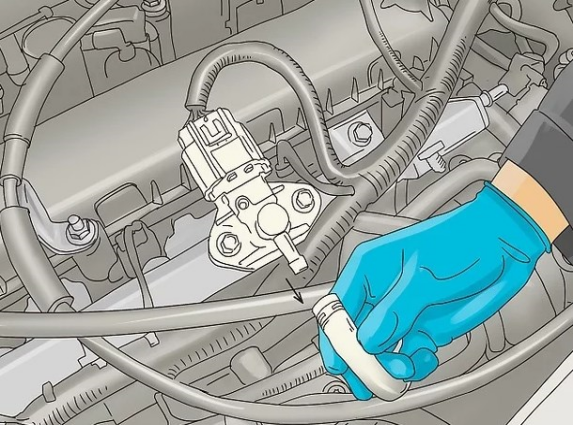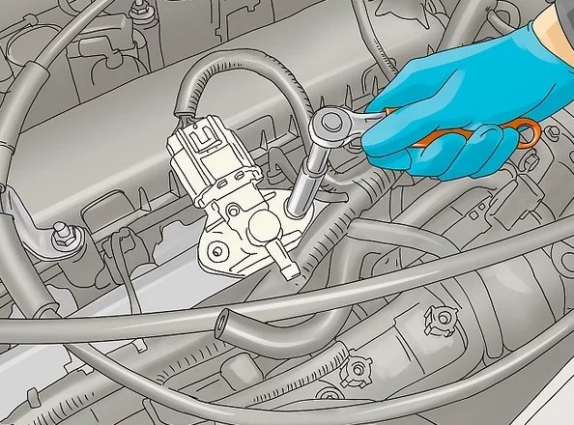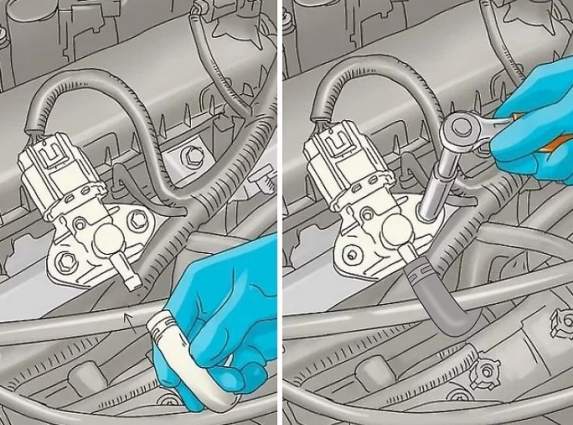The Manifold Absolute Pressure (MAP) sensor is an important component in a vehicle's engine management system, as it monitors the pressure inside the intake manifold. Here are some common signs that may indicate it is time to replace the MAP sensor:

1. Check Engine Light (CEL) is illuminated:
- If the MAP sensor is failing or providing faulty readings, it may trigger the Check Engine Light on the dashboard. A diagnostic scan with an OBD-II scanner can help identify the specific error code related to the MAP sensor.
2. Poor Engine Performance:
- A malfunctioning MAP sensor can lead to poor engine performance, including rough idling, stalling, hesitation, lack of power, or difficulty starting the engine. If you notice a decrease in overall engine performance, the MAP sensor could be a potential culprit.
3. Abnormal Fuel Economy:
- A faulty MAP sensor may cause incorrect air-fuel mixture calculations by the engine control unit (ECU), leading to reduced fuel efficiency. If you observe a sudden drop in fuel economy without any apparent reason, it could be a sign of MAP sensor failure.
4. Black Smoke from Exhaust:
- An overly rich air-fuel mixture resulting from a malfunctioning MAP sensor can lead to excessive fuel being injected into the engine. This can produce black smoke emitting from the exhaust system, indicating a potential issue with the MAP sensor.
5. Engine Surging or Hesitation:
- Inconsistent or erratic engine performance, such as surging or hesitation during acceleration or deceleration, can be a symptom of a failing MAP sensor. The ECU relies on accurate pressure readings from the MAP sensor to adjust fuel delivery, ignition timing, and other parameters for smooth engine operation.
6. High Idle Speed:
- A malfunctioning MAP sensor may cause the engine to idle at a higher speed than normal. If you notice persistent high idle speed when the engine is warm, the MAP sensor might need replacement.
7. Reduced Engine Power:
- If the MAP sensor is not functioning correctly, the engine may experience a loss of power or performance. This can be especially noticeable during acceleration or when climbing hills.
8. Visible Damage or Contamination:
- Physical damage to the MAP sensor, such as cracks, corrosion, or contamination by dirt or oil, can interfere with its proper operation. If you observe any visible signs of damage, replacement may be necessary.
If you experience any combination of these symptoms or suspect issues with the MAP sensor during diagnostic tests, it is advisable to have the sensor inspected by a qualified mechanic. Replacing a faulty MAP sensor in a timely manner can help restore engine performance, optimize fuel efficiency, and prevent potential damage to the vehicle's engine and emission control systems.
What are the Signs of a Bad MAP Sensor
A malfunctioning MAP (Manifold Absolute Pressure) sensor can cause various issues with an engine's performance and efficiency. Here are common signs that may indicate a problem with the MAP sensor:
1. Check Engine Light (CEL) Activation:
- The most common indicator of a faulty MAP sensor is the illumination of the Check Engine Light on the dashboard. When the sensor malfunctions or provides erratic readings, the Engine Control Module (ECM) may trigger the warning light.
2. Poor Engine Performance:
- Rough Idling: The engine may experience rough idling, stalling, or fluctuating idle speeds when the MAP sensor is not functioning correctly.
- Hesitation or Surging: The engine may hesitate during acceleration, exhibit surging behavior, or have difficulty maintaining a consistent speed.
3. Reduced Fuel Efficiency:
- A malfunctioning MAP sensor can lead to incorrect air-fuel mixture calculations by the ECM, resulting in reduced fuel efficiency and potentially higher fuel consumption.
4. Engine Misfires:
- Misfires can occur due to incorrect fuel injection caused by faulty MAP sensor readings. This can lead to rough running, loss of power, and potential damage to the engine over time.
5. Black Smoke from Exhaust:
- An overly rich air-fuel mixture due to a malfunctioning MAP sensor can lead to black smoke coming from the exhaust. This indicates incomplete combustion and excessive fuel being burned.
6. Stalling or Difficulty Starting:
- A bad MAP sensor can cause the engine to stall unexpectedly or have difficulty starting, particularly when idling or during acceleration.
7. Loss of Engine Power:
- The engine may experience a significant loss of power, especially during acceleration or under load, when the MAP sensor is not functioning correctly.
8. Increased Emissions:
- Malfunctioning MAP sensors can cause the engine to run rich, leading to increased emissions of pollutants such as hydrocarbons and carbon monoxide.
9. Erratic Idle Speeds:
- Fluctuations in idle speed, such as high or low idle speeds, can be a sign of a failing MAP sensor influencing the engine's air-fuel mixture.
10. Poor Performance in High Altitudes:
- Inadequate altitude compensation due to a faulty MAP sensor can result in poor engine performance at higher elevations.
If you notice any combination of these symptoms, it is advisable to have the MAP sensor inspected and, if necessary, replaced by a qualified mechanic. Addressing a faulty MAP sensor promptly can help restore engine performance, improve fuel efficiency, and prevent potential damage to the engine and emission control systems.
How to Replace MAP Sensor
Replacing the Manifold Absolute Pressure (MAP) sensor involves a straightforward process that can often be done with basic tools. Here is a general guide on how to replace a MAP sensor:

Tools and Materials Needed:
- New MAP sensor
- Socket and ratchet set
- Screwdrivers (flathead and Phillips)
- Safety gloves and goggles
- Cleaning cloth
- Electrical contact cleaner (optional)

Steps to Replace a MAP Sensor:
-
Locate the MAP Sensor:
- The MAP sensor is typically located on or near the intake manifold, connected by a vacuum hose and an electrical connector.
-
Disconnect the Battery:
- As a safety precaution, disconnect the negative terminal of the vehicle's battery to avoid any electrical mishaps.
-
Remove the Old MAP Sensor:
- Disconnect the electrical connector: Press down on the tab and carefully unplug the connector from the sensor.
- Remove the vacuum hose: Depending on the design, you may need to loosen a clamp or connector to detach the vacuum hose from the sensor.
- Unscrew the sensor: Use a suitable socket or screwdriver to remove the mounting screws that secure the MAP sensor in place. Carefully take out the old sensor.
-
Prepare the Area:
- Clean the mounting area with a cloth to ensure a clean surface for the new sensor. You can also use electrical contact cleaner to remove any dirt or debris.
-
Install the New MAP Sensor:
- Attach the new sensor: Position the new MAP sensor in place and secure it with the mounting screws. Make sure it is aligned correctly.
- Reconnect the electrical connection: Plug in the electrical connector until it clicks into place.
- Reconnect the vacuum hose: Attach the vacuum hose securely to the new MAP sensor.
-
Reconnect the Battery:
- Reconnect the negative terminal of the vehicle's battery.
-
Test the Sensor:
- Start the vehicle and ensure that the engine runs smoothly. Check for any warning lights on the dashboard that may indicate a problem with the new MAP sensor.
-
Clear Codes (if applicable):
- If the Check Engine Light was triggered by the old MAP sensor, you may need to clear any error codes using an OBD-II scanner.
-
Final Checks:
- Double-check all connections to ensure they are secure. Take the vehicle for a test drive to confirm that the new MAP sensor is functioning correctly.

If you encounter any difficulties or are unsure about the replacement process, it is recommended to consult a professional mechanic for assistance. Proper installation of the MAP sensor is crucial to maintain the engine's performance and fuel efficiency.

Where to Buy MAP Sensor
MAP sensors can be purchased from various sources, both online and in physical retail stores. Here are some common places where you can buy a MAP sensor:

1. Auto Parts Stores:
- Visit local auto parts stores such as AutoZone, O'Reilly Auto Parts, Advance Auto Parts, NAPA Auto Parts, or Pep Boys. These stores often carry a variety of automotive sensors, including MAP sensors.
2. Dealership Parts Department:
- Contact your vehicle's manufacturer or visit a local dealership parts department to purchase an OEM (Original Equipment Manufacturer) MAP sensor specific to your vehicle make and model.
3. Online Retailers:
- Amazon: Amazon offers a wide selection of MAP sensors from various brands. Ensure you have your vehicle's specific details for compatibility.
- RockAuto: RockAuto is an online auto parts store that provides a vast range of automotive parts, including MAP sensors.
- eBay: eBay is another platform where you can find new and used MAP sensors for sale.
- CarParts.com: This website specializes in selling a variety of auto parts, including MAP sensors.
4. Local Mechanics or Repair Shops:
- Some local mechanics or repair shops may also sell automotive parts, including sensors like MAP sensors. They may provide installation services as well.
5. Specialized Online Stores:
- There are online stores like PartsGeek, 1A Auto, and Summit Racing that specialize in selling auto parts and may offer a selection of MAP sensors.
6. Automotive Forums and Marketplaces:
- Participate in automotive forums or check online marketplaces like Craigslist or Facebook Marketplace for potential deals on new or used MAP sensors.
Important Considerations:
- Compatibility: Make sure the MAP sensor you purchase is compatible with your vehicle's make, model, and year.
- Quality: Opt for reputable brands or OEM parts to ensure reliability and performance.
- Warranty: Check if the MAP sensor comes with a warranty for added protection against defects.
- Reviews: Look for reviews and ratings of the MAP sensor or the seller to ensure customer satisfaction.
Before purchasing a MAP sensor, gather information about your vehicle’s specifications and requirements. If you're unsure about which MAP sensor is suitable for your vehicle, consider consulting a mechanic or automotive professional for guidance.



